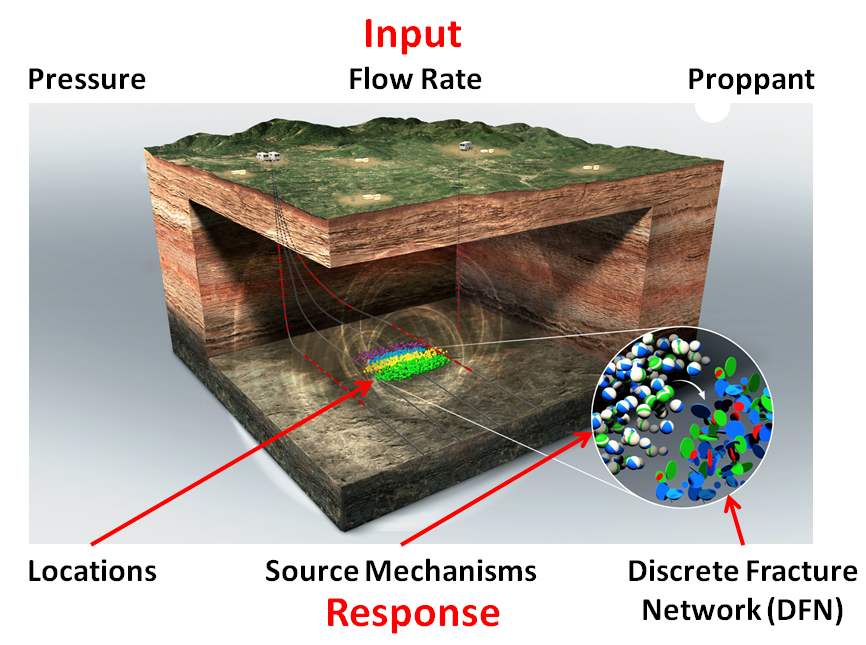Integral to any hydraulic fracturing project is having the insight into how fracturing strategies are affecting the rock. Microseismic monitoring is an essential tool that detects the very small seismic events that occur during hydraulic fracturing and provides an image of how a program is developing. Basic microseismic monitoring can provide insight into stage half-lengths, the overlap between stages and out-of-zone fracturing/growth. To get the most out of a microseismic program and observe a frack in more detail, advanced analysis should be applied. ESG’s advanced technique can construct and visualize the discrete fracture network (DFN).
Advanced analysis takes microseismic events beyond just locations and magnitudes. Using seismic moment tensor inversion (SMTI), the source mechanism of the events (whether the event rupture was an opening, closing, slipping or shear movement) and orientations of the individual ruptures are determined. With this information, a robust DFN can be identified. DFN models show the interconnected pathways that are formed in the rock as a result of hydraulic fracturing, through which fluids and proppant may flow. Knowing where these pathways have been created is vital to any hydraulic fracturing program.
A few microseismic vendors have proposed that DFNs can be constructed by connecting the hypocenters of the microseismic events and obtaining the orientations and fracture lengths based on this network. However, through ESG’s technique, these events can now be assigned fracture orientations using SMTI, and the length of these fractures can be determined by the frequency content of the waveforms generated by the event. By combining both the orientation and length of the fractures using high-quality events, the company’s technique can create a more data-driven DFN. The user can then extend those known orientations and lengths to non-SMTI events, forming an even more detailed model. “A robust DFN model is essential for accurately determining where your proppant and fluid are being distributed,” said Dr. Ted Urbancic, CTO at ESG.
To generate this robust DFN, SMTI events are visualized as penny-shaped cracks oriented in a 3-D space sized according to the individual rupture lengths. Using ESG’s methodology, the orientations of the DFN are first estimated through SMTI and then are extended to non-SMTI events through an optimization algorithm.
ESG’s technique was used on a large-scale multiwell hydraulic fracturing project in the Horn River Basin in Northeast British Columbia. The Horn River Basin is a shale gas play that is made up of three members (in order of increasing depth): the Muskwa, Otter Park and Evie. The pad comprised 10 horizontal wells and was completed using a zipper frack technique. Three of ESG’s geophone arrays were deployed in the vertical sections of nearby wells and collected data for 76 stages. More than 90,000 events were located over these stages, ranging in magnitudes (M) from above -3 M to 1 M, providing a good basis for examining questions on the progression of hydraulic fracturing in the reservoir. The DFN provided the user with a basis for refining geomechanical models, allowing it to better predict propped volumes and reservoir performance over time.

Recommended Reading
E&P Highlights: March 3, 2025
2025-03-03 - Here’s a roundup of the latest E&P headlines, from planned Kolibri wells in Oklahoma to a discovery in the Barents Sea.
SLB Launches Electric Well Control Tech to Replace Hydraulics
2025-03-04 - SLB says the new systems reduce costs and provide real-time data for operators.
SLB’s Big Boost from Digital Offsets Flat Trends in Oil, E&P
2025-01-20 - SLB’s digital revenue grew 20% in 2024 as customers continue to adopt the company's digital products, artificial intelligence and cloud computing.
Then and Now: 4D Seismic Surveys Cut Costs, Increase Production
2025-03-16 - 4D seismic surveys allow operators to monitor changes in reservoirs over extended periods for more informed well placement decisions. Companies including SLB and MicroSeismic Inc. are already seeing the benefits of the tech.
Diamondback in Talks to Build Permian NatGas Power for Data Centers
2025-02-26 - With ample gas production and surface acreage, Diamondback Energy is working to lure power producers and data center builders into the Permian Basin.
Comments
Add new comment
This conversation is moderated according to Hart Energy community rules. Please read the rules before joining the discussion. If you’re experiencing any technical problems, please contact our customer care team.





